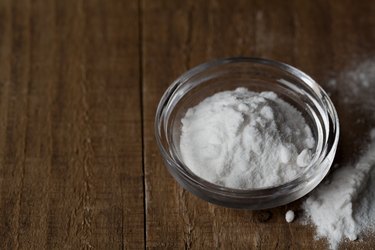
At its most elemental level, the art of cooking is about chemistry, namely how food components react with one another. Acids and bases are the foundation of these chemical reactions in food preparation. The ways that acids and bases work together can enhance flavor, tenderize seafood and meat, get baked goods to rise properly and even put out a kitchen fire.
Chemistry 101
Video of the Day
An acid is a solution with a value between 1 and 6.99 on the pH scale, a chemical gauge of acidity and alkalinity that goes from 1 to 14. A base is a substance with a pH value greater than 7. Bases are termed "alkaline," meaning that they neutralize acids. Water, which has both acid and base, is considered chemically neutral, having a pH of 7.
Video of the Day
Pucker Up
Acids make foods taste sour, and most foods fit for humans to eat tend to have more acid than base in their composition. Natural sugars in the food counterbalance acids' sour flavors to make them taste better. Think of the difference between eating a slice of orange vs. a slice of lemon. With much more natural fruit sugar, or fructose, the orange is much tastier than the lemon.
Tenderizing Effects
Acids serve to soften, or "denature," foods that have lots of proteins. The fish appetizer known as ceviche is "cooked" in lime juice, an acid that breaks down proteins in the fish. The lime juice's effect on the fish proteins gives the dish an appealing mouth texture and an opaque appearance that resembles cooking with heat. Tough cuts of meat often are soaked in marinades made with vinegar, lemon juice, tomato juice or other types of acids to tenderize them and add flavor. Marinades don't penetrate deeply into meat without piercing the flesh extensively, so the acid helps to open up the outer protein cells to accept the seasoning.
Soapy Results
Cooking with bases is a little trickier, because alkaline substances react with fats in recipes to turn into soap, which is hardly a tasty result. Before modern food processing, indigenous peoples would "cook" maize, or corn, in the alkaline ashes from their cooking fires. The process softened the outer hulls of corn kernels, making them easier to digest and releasing important nutrients.
Baking Soda Lifts Batter
Bases play an essential role in baking for their ability to react with acids and release carbon dioxide gas. Baking soda is the most common base used in cooking. Gas bubbles form in batter or dough when baking soda combines with any acidic ingredients, such as yogurt, lemon juice or buttermilk. This process is known as leavening, a reaction that causes batter or dough to rise up. However, baking soda can only cause so much lift unless there's a great deal of it in the recipe, which can result in a soapy taste to baked goods. That's why some recipes also call for baking powder, a product that combines baking soda with a powdered acid that reacts with water. "Double-acting" baking powder can be especially helpful because it responds to the oven's heat to create a second chemical reaction, causing even more leavening to the cake or bread.
Baking Soda Puts Out Fires
Baking soda has one other advantage in the kitchen -- it's a natural fire extinguisher. Known chemically as sodium bicarbonate, baking soda breaks down at 158 degrees Fahrenheit into sodium carbonate, carbon dioxide gas and water vapor. This reaction will smother any kitchen fire that shouldn't be doused with water, such as flaming oil or grease.